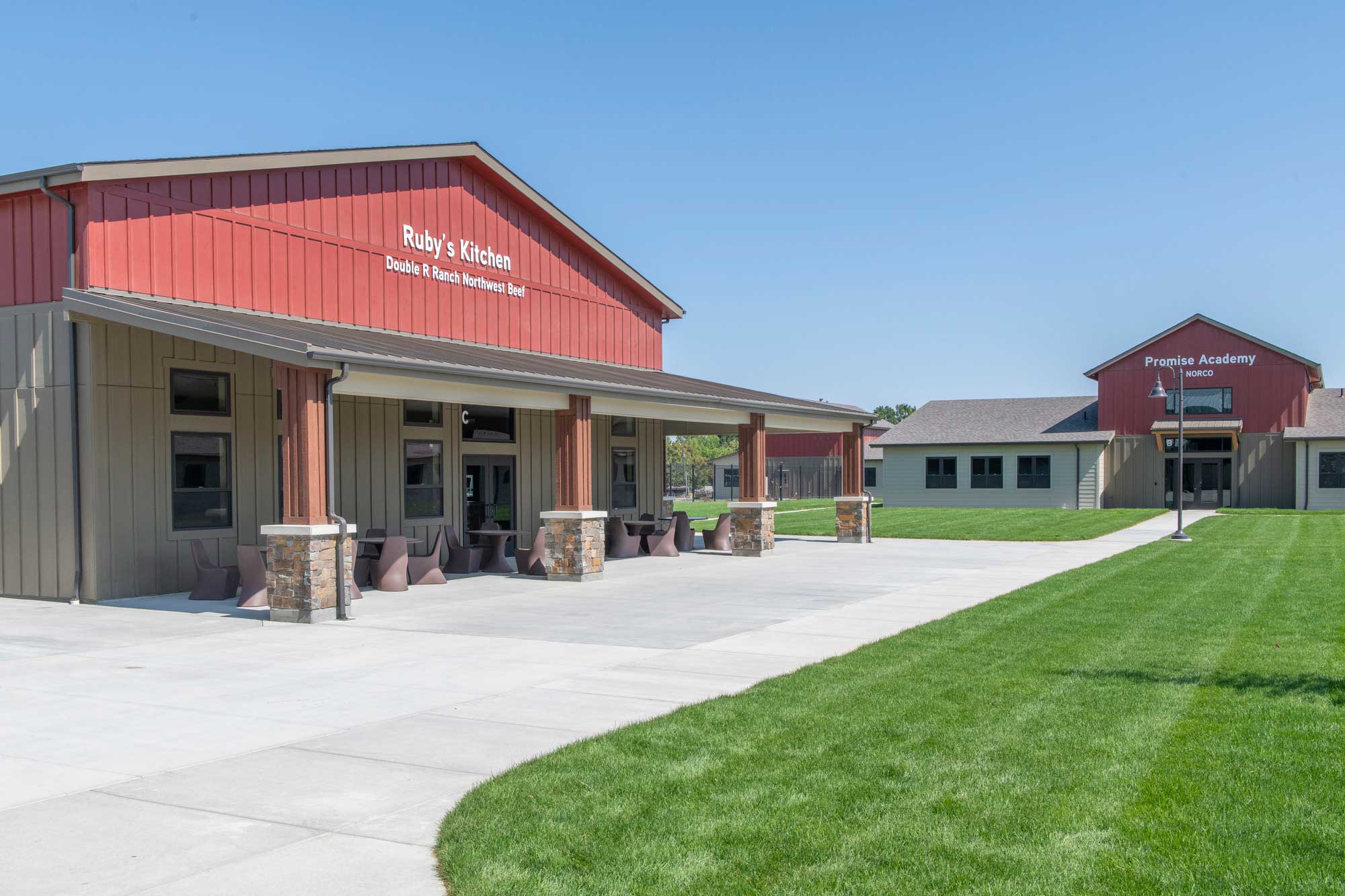Hands of Promise Campus: How Integrated, Community-Supported Design Resulted in a One-of-a-Kind Project
The Idaho Youth Ranch’s Hands of Promise Campus is a multi-phase project that began in 2015 with master planning and site design by The Land Group and which celebrated the opening of its Residential Center for Healing and Resilience in August 2023. Designated as a psychiatric residential treatment facility, the 64-bed facility will serve more than 100 Idaho children and teens annually with the goal of keeping kids closer to home.
Cushing Terrell, along with The Land Group and Erstad Architects, has been involved with the project since its inception, partnering on various phases of the design for the 258-acre campus, which includes two residence halls, a wellness center, a dining and recreation hall, an education center, a welcome center for families, and an equestrian facility. The buildings and services are all designed to support the physical, emotional, and educational needs of the young people who live there.
Defining the Goals of the Project
The project team utilized Cushing Terrell’s Sustainable Design Initiative tool — which aligns with the AIA Framework for Design Excellence — to establish goals for the overall campus project. They included:
- Design for Economy to maximize the Idaho Youth Ranch’s investment;
- Design for Energy to provide robust, energy-efficient systems with low operating costs;
- Design for Change to ensure resilience in case of power outages and flexibility related to space needs; and
- Design for Discovery to realize places where individuals with differing needs and abilities can heal, learn, and thrive.
Early phases of the project included work to bring power and plumbing to the undeveloped site, as well as a water and wastewater treatment facility. While the site is served by Idaho Power, one of the initial projects was a pro-bono effort to install a 100kW solar array to offset power costs for the campus. The solar installation was a team effort with renewable energy company Clēnera sponsoring the project and donating the solar panels and Cushing Terrell, Erstad Architects, The Land Group, and Jordan-Wilcomb Construction executing the project. The solar array of 300-plus panels produces enough power to offset 20% of the campus energy, which is equivalent to about 25 homes.
“Energy modeling and life-cycle cost projections were utilized to help the Idaho Youth Ranch make informed decisions about the mechanical systems, fuel types, and envelope design,” said Tim Johnson, a director of sustainability with Cushing Terrell who leads our energy modeling team. The analysis weighed the costs of energy, investments, and maintenance, giving the team a good way to compare all options equally. The Youth Ranch ultimately chose an efficient air-source heat-pump system that aligned with the project’s budget and resulted in an all-electric campus supported by renewable energy.

A solar array of 300-plus panels on the Hands of Promise Campus produces enough power for up to 25 homes and is one of the largest solar-powered net-metering projects in Idaho.
Bringing the Campus to Life
Following the utilities phase, one of the first buildings completed on the campus was an equestrian facility where children and families can experience Equine Assisted Therapy (EAP). Working with horses and an equine mental health specialist is a method the Idaho Youth Ranch uses to support emotional recovery and create empathetic connections. Surrounded by fields and streams, the Equine Therapy Center comprises an arena, stables, and barns. In addition to providing EAP for children and teens, the center supports the Ride for Joy program, which offers therapy for wounded veterans.
Cushing Terrell and Erstad Architects partnered on the equestrian facility with R & M Steel, who also donated materials, and Jordan-Wilcomb Construction.
With the Equine Therapy Center complete, phase two of the project involved the design and construction of buildings that would support and temporarily house young people between the ages of 11 and 17. Design for the Residential Center for Healing and Resilience was another partnership of Cushing Terrell, who served as the architect for the two residence halls and provided MEP (mechanical, electrical, and plumbing) and structural engineering for all buildings, and Erstad Architects who was the architect of record for the welcome center, education and wellness buildings, and the recreation facility. As part of the effort to design for resilience, the facility has the capacity to expand and add another residence hall and an estimated 32 beds for future needs.
The close relationship between Cushing Terrell and Erstad Architects was exceptionally helpful given the challenge of progressing such a large project during the pandemic.

The Idaho Youth Ranch’s Residential Center for Healing and Resilience includes two residence halls, a wellness center, a dining and recreation hall, an education center, a welcome center for families, and an equestrian facility. It’s located on the 258-acre Hands of Promise Campus, surrounded by streams, forests, and fields.
Finding Inspiration
The overarching design theme for the project was inspired by the idea of a journey — for the young people and their families. The experience of coming to the facility, being welcomed into the spaces, and continuing through the healing and learning journey and on to graduation was carefully considered, thinking in terms of how it would feel to bring your child to the Hands of Promise Campus as well as how it would feel to live there for what could be months at a time.
“When designing a facility of this type, there are two critical things to address — first and foremost the health and safety of the residents and secondly, how to create a place that has a home-like feel where the kids can be themselves and be comfortable,” said Cushing Terrell Project Architect Amy Lindgren. “It’s a balance that we achieved by incorporating safety and security measures, while ensuring spaces are open and light-filled with high ceilings, large windows, and warm colors — really taking a cue from the surrounding natural landscapes and tying this into the theme of being on a journey.”
“The facility is built around the needs of youth who’ll be seeking care there. Each of the six classrooms have restrooms. Hallways are extra wide to let clients maintain personal space. Kids who struggle to sit still in class can even use fidget-friendly seats. The facility’s carpeted floors, wooden ceilings, and large windows are also meant to feel more familiar,” said Jeff Myers, Vice President of Marketing and Communications for the Youth Ranch.
The interior designer for the project, Samantha Boucher, took the journey theme to the next level by working with local artists to create huge murals of Idaho landscapes on the walls of the buildings. The murals depict everything from lazy, meandering trails and wildflower-filled meadows to river ravines and steep paths through mountain passes. Karen Eastman curated the art, and the local artists featured include Pat Kilby, Collin Pfeifer, Lorelle Rau, and Rachel Teannalach.
The Hands of Promise Campus was made possible by the will and determination of the Idaho Youth Ranch to make a difference for Idaho kids, by the local businesses and firms that contributed and worked together as a team, by the fundraising consulting work of Donor by Design Group, and through the generous community support from all those who contributed to the capital campaign.
This is a project that can make a huge difference in young people’s lives, rippling out in so many ways, and we couldn’t be more thankful for each person who made it possible.

